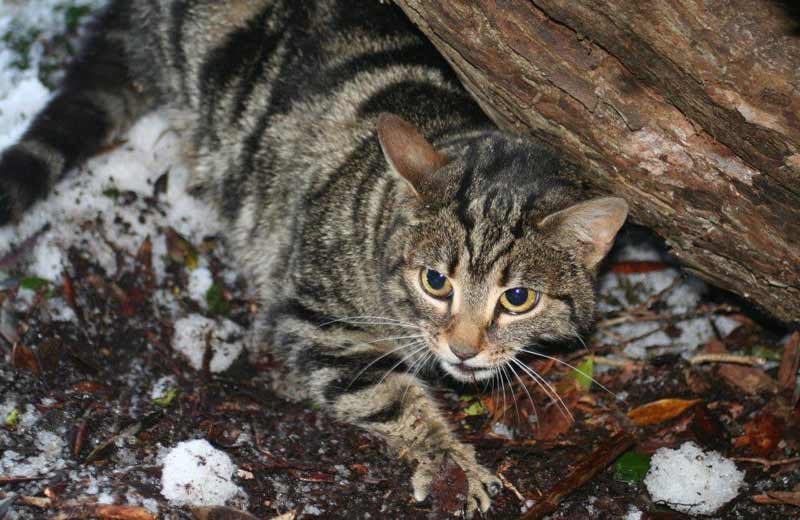The Environmental Terrorists in Your Home? Cats.
You’ve probably seen them on TikTok, Instagram or wandering around the city: people walking their cats on leashes. Crazy, I know, but walking cats on leashes can serve as a great compromise between letting cats explore outdoors and responsible ownership. If your cat is interested in exploring outside, allowing them to roam freely without restraint or supervision makes you complicit in the environmental degradation that they cause. The dead mouse your cat dropped off in front of you is not just gross, but indicative of the fact that they are playing an active part in the destruction of local biodiversity — biodiversity that, as the climate crisis begins visibly impacting our world, is becoming increasingly important.
According to a government document published by the United States Department of Agriculture (USDA), “scientific studies estimate that freeranging and feral cats kill 1.3 to 4.0 billion birds and 6.3 to 22.3 billion mammals annually in the United States.” Most of these animals, as the paper later explains, are native species. The vast majority of these animals are also not killed for dietary purposes, as many victims are abandoned at the site of the attack. That same paper explains that cats bring 23% of their kill home, eat 28% at the kill site and abandon the remaining 49%. So, for every dead or dying mouse your cat brings home, it left two others dead and unconsumed. It is for these reasons that the USDA has classified cats as an invasive species, and one of the most individually destructive ones.
Now, that is not to say cats are awful creatures. While I have the unfortunate luck to be allergic to them, I love cats. They’re cute, fun and curious. That last attribute makes many cats uninterested in spending a lifetime fully indoors, which prompts their owners to allow them to free-roam outside. Free-roaming, however, is irresponsible animal ownership. Besides the destruction of native species, it threatens the health of both humans and cats. A cat roaming freely is much more likely to come into contact with another cat, free-roaming or feral, who might have a variety of harmful diseases, such as Feline Immunodeficiency Virus (FIV). More pressing, however, is the threat that they can pose to human health.
The first disease most often associated with free-roaming cats is rabies, a fatal disease that humans contract from interacting with wild animals. While rabies is very serious (and why you should never try to pet wild animals), very few people contract rabies from free-roaming cats. The much more serious disease that cats are almost solely responsible for is taxoplasmosis. 6% of all U.S. citizens six years or older have the disease, although many might not know. Lots of people who contract the disease might not have any symptoms, but for the immunocompromised it can cause “behavioral changes, blindness and even death.” For example, pregnant women who contract the disease will pass it onto their unborn babies, which can result in diseases of the nervous system and eyes that will impact the entirety of a newborn victim’s life.
The blame for this disease falls primarily on cats because the bacteria that causes toxoplasmosis, Toxoplasmosis Gondii, can only reproduce in the digestive tracts of felines. While there, the bacteria will create oocysts, a stage in the bacteria’s reproductive cycle. Kittens and cats, when infected, will shed oocysts for up to three weeks in their fecal matter. These oocysts then spread through the ground and water, posing dangers to the animals that eat plants grown in infected soil and drinking infected water. Most cases of toxoplasmosis come from humans ingesting infected vegetables (sometimes from their own backyard gardens) and infected meat. Allowing your cat to free-roam increases the likelihood of their being infected by this bacterium, which then puts you and your neighbor’s health at risk.
So, letting your cat outside endangers the environment, their safety and human health. Should all cats be doomed to spend their entire life indoors? Absolutely not.
On TikTok, Instagram and other social media sites, a handful of individuals have gone viral for showing how they “walk” their cats. John Yoshihara Jr. posts videos of his cat accompanying him on hikes, trotting down mountain paths on his little paws. The account @surfercatmarv posts pictures, tips and links on Instagram for people interested in leash-training their cats. Leash-walking cats is gaining popularity online, as more and more people try it.
Even Jackson Galaxy, the Cat Daddy himself, recommends attempting it. In a blog post from June 2021, Galaxy responds positively to a young woman asking whether or not she should continue taking her cat on walks (and dump the boyfriend mocking her for it). Galaxy referred positively to both, offering tips for people to keep in mind if they are interested in walking their cats. His most important tip: walking a cat is very different from walking a dog. “The cat controls where you go and what you do,” wrote Galaxy. “Ultimately, it’s supervised outdoor playtime.”
The word “supervised” is crucial. The dangers of free-roaming cats come from the irresponsibility of cat owners, who, often because letting cats free-roam is such a common practice, neglect to realize the greater implications of their cats’ actions. Cats need to be supervised when they are outdoors, and a great way of doing so is by walking them on a leash.
Kari White, FCRH ’24, is an English major from Wilmington, Del.

Kari White is a senior from the blink-and-you’ll-miss-it state of Delaware. She is majoring in English with a concentration in creative writing, as well...










































































































































































































